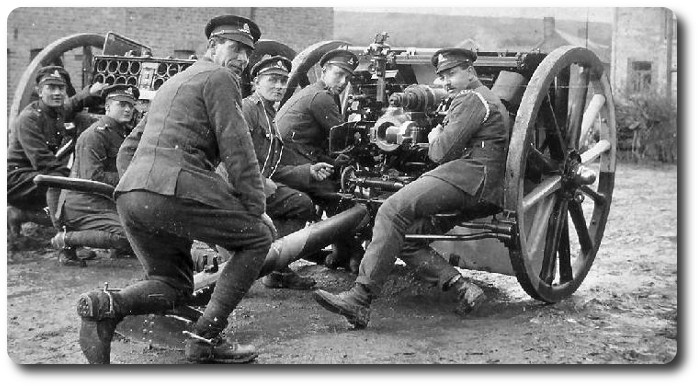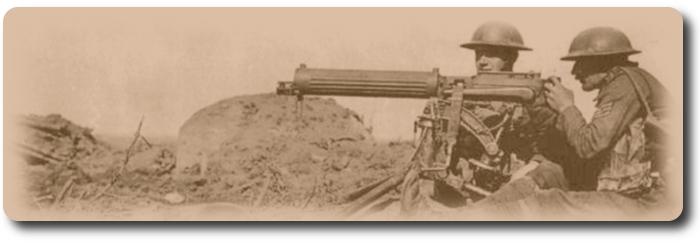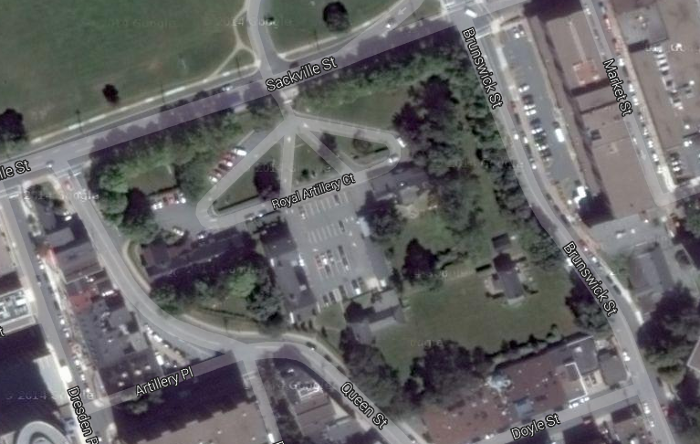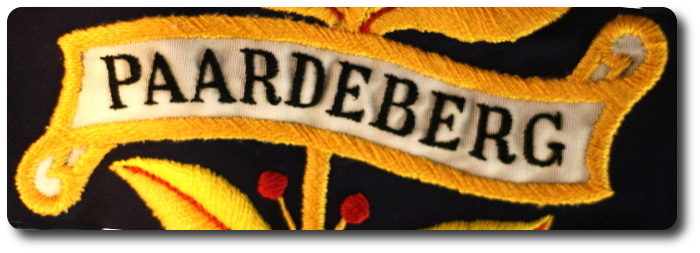"A" Company, Royal School of Infantry
Topic: The RCR

Our Permanent Troops, II
"A" Company, Royal School of Infantry
The Dominion Illustrated, 6th December 1890
 The Royal School of Infantry for the Maritime Provinces is, like that for the Province of Quebec, already described in The Dominion Illustrated, based on the Infantry School Corps—"A" Company and staff being stationed at Fredericton, N.B. In this issue we reproduce photographs of the staff, the corps on parade, and the principal barracks. The corps was organized on the 25th December, 1883, the then three commandants, Lieut.-Colonels Maunsell, D'Orsonnens and Otter, having previously been attached to the force at Aldershot, England, and the Company officers, including Major Gordon and Captain Hemming, of "A" Company, to Her Majesty's troops, at Halifax, N.S., with the view to picking up modern ideas in "soldiering." Since that time the wisdom of basing this branch of Canada's permanent force upon British infantry regulations and traditions has been proved—the regimental system of the corps has, step by step, developed and improved, and the practical utility of the school has been amply tested. On the 19th July, 1887, another, Company "D," that at London, Ont., has been added to the corps, and Lieut.-Colonel Smith, after much experience, appointed to command.
The Royal School of Infantry for the Maritime Provinces is, like that for the Province of Quebec, already described in The Dominion Illustrated, based on the Infantry School Corps—"A" Company and staff being stationed at Fredericton, N.B. In this issue we reproduce photographs of the staff, the corps on parade, and the principal barracks. The corps was organized on the 25th December, 1883, the then three commandants, Lieut.-Colonels Maunsell, D'Orsonnens and Otter, having previously been attached to the force at Aldershot, England, and the Company officers, including Major Gordon and Captain Hemming, of "A" Company, to Her Majesty's troops, at Halifax, N.S., with the view to picking up modern ideas in "soldiering." Since that time the wisdom of basing this branch of Canada's permanent force upon British infantry regulations and traditions has been proved—the regimental system of the corps has, step by step, developed and improved, and the practical utility of the school has been amply tested. On the 19th July, 1887, another, Company "D," that at London, Ont., has been added to the corps, and Lieut.-Colonel Smith, after much experience, appointed to command.
At the time of the North-West rebellion, May, 1885, "A" Company, with staff I.S.C., was used as the basis of a battalion to represent New Brunswick and Prince Edward Island on active service. With marvellous rapidity a most efficient battalion (569 strong) was formed, the call to arms having been promptly responded to, alike from town and country, from village and hamlet. Representatives of every industry, every profession, every class and creed were found in this battalion. The following composed the staff:—
- Commandant—Lieut.-Col. Maunsell, D.A.G.
- Majors—
- Lieut.-Colonel Beer, 74th Battalion;
- Lieut.-Colonel Blaine, 62nd Fusiliers.
- Captains—
- "A" Company — Major Gordon, I.S.C.
- "B" Company — Lieut. Young, I.S.C.
- " Company — Capt. Sturdee, 62nd Batt.
- "D" Company — Lieut. Gosard, 62nd Batt.
- "E" Company — Lieut. Hegan, 62nd Batt.
- " Company — Lieut. Edwards, 62nd Batt.
- "G" Company — Lieut. Baker, 67th Batt.
- "H" Company — Lieut. Howe, 71st Batt.
- "I" Company — Lieut. Harper, 74th Batt.
- "J" Company — Lieut. McNaughton, 73rd Batt.
- "K" Company — Lieut. Stewart, 82nd P.E.I.
- "L" Company — Lieut. MacLeod, 82nd P.E.I.
- Adjutant—Capt. McLean, 62nd.
- Paymaster—Lieut.-Col. McCulley, 73rd.
- Quartermaster—Major Devlin, 62nd.
- Surgeon—Surgeon Brown, I.S.C.
- Assistant Surgeon—Assistant Surgeon McFarland, 62nd.
The battalion having proceeded en route to the front, encamped at Sussex, and their services being no longer required, having received the thanks of the authorities, returned to their homes on the 26th May.
It may be interesting to note that the School of Infantry, at Fredericton, serves as a mean of military education for the following battalions of infantry in the Maritime Provinces:—
- Nova Scotia
- 63rd Battalion, Halifax Rifles;
- 66th Battalion, Princess Louise Fusiliers;
- 68th, King's County Battalion of Infantry;
- 69th, 1st Annapolis Battalion of Infantry;
- 72nd, 2nd Annapolis Battalion of Infantry;
- 75th, Lunenburg Battalion of Infantry;
- 78th, Colchester, Hants and Picton Battalion of Infantry, "Highlanders;"
- 93rd, Cumberland Battalion of Infantry;
- 94th, "Victoria" Battalion of Infantry, "Argyle" Highlanders;
- New Brunswick
- 62nd Battalion, St. John Fusiliers;
- 67th Battalion, Carleton Light Infantry;
- 71st, York Battalion of Infantry;
- 73rd, Northunberland Battalion of Infantry;
- 74th Battalion of Infantry;
- St John Rifle Company.
- Prince Edward Island
- 82nd, Queen's County Battalion of Infantry.
During the seven years the school has been in operation 167 officers and 342 non-commissioned officers have been instructed and receive certificates of qualification. This speaks volumes foe th practical utility of the schools, the commandant receiving abundant support in the bring forward of officers and non-commissioned officers for instruction from staff officers Lieut.-Colonel Worsley, D.A.G. Nova Scotia, and Lieut.-Colonel Irving, Brigade Major, Prince Edward Island, who are well aware that without an efficient means of instruction for officers and non-commissioned officers battalions of the active militia must deteriorate, and in proportion to the numbers and competence of officers and non-commissioned officers so is the degree of efficiency attainable and attained.
On the Queen's Birthday, 1886, Lady Tilley, who, as well as H.H. the Lieut. Governor, is ever ready to foster and encourage that which has for its object the good of the service, or the good of the community, with the sanction of the Lieut.-Governor in command, presented a regimental colour to this detachment of the I.S.C., regarding its importance not only as a mere Company of Infantry, but as the nucleus of a battalion, with a regimental staff and efficient band, and knowing that everything calculated to create esprit de corps tends to increase efficiency.
So much, in brief, regarding the corps, its organization, its steps of progress and its usefulness.
 A word, in conclusion, as to the barracks at Fredericton, of which we give two sketches, may not be without interest. There are three (3) barracks, viz.:—1. Officers' quarters (stone and wood); 2. Mens' barracks (stone); 3. Married non-commissioned officers' and mens' quarters—Park barracks—(wood). These barracks were originally built for a half-battalion of Imperial Infantry, with a Battery of Garrison Artillery, but, by using temporary quarters in town for officers and men, a whole battalion of infantry has, at times, been stationed at Fredericton. With modern requirements, however, these barracks are now adapted for 6 officers, 10 attached officers, 100 permanent non-commissioned officers and men, 30 attached non-commissioned officers and men; total 146 all ranks.
A word, in conclusion, as to the barracks at Fredericton, of which we give two sketches, may not be without interest. There are three (3) barracks, viz.:—1. Officers' quarters (stone and wood); 2. Mens' barracks (stone); 3. Married non-commissioned officers' and mens' quarters—Park barracks—(wood). These barracks were originally built for a half-battalion of Imperial Infantry, with a Battery of Garrison Artillery, but, by using temporary quarters in town for officers and men, a whole battalion of infantry has, at times, been stationed at Fredericton. With modern requirements, however, these barracks are now adapted for 6 officers, 10 attached officers, 100 permanent non-commissioned officers and men, 30 attached non-commissioned officers and men; total 146 all ranks.
On the formation of the Infantry School Corps—January, 1884—these barracks were found to be much in need of repairs and remodeling.
When the improvement in class and education of the modern recruits is considered, as compared with the status of the so-called common soldier of the past, improvement in quarters and surroundings becomes a necessity. Not only is this improvement now to be found in the barrack rooms—the "home" of the soldiers at this station—but also in the providing suitable recreation rooms and library in the Drill Hall, as well as in the providing comfortable quarters, with gardens, for the non-commissioned officers and men on the married strength. All this is in addition to improved conditions of service, as to pay, clothing, rations, &c., referred to in previous issue. It may be added that increased attention is not paid to the care of grounds,—the officers' barracks grounds being laid out in gardens, lawn tennis courts, gravel walks, &c. The dates of erection of these barracks are as follows:—Officers' barracks, 1841; mens' baracks, 1827; married non-commissioned officers' and men's quarters (Park barracks), 1838; isolated quarters therein, 1789.
The following troops have occupied the barracks from time to time since 1846, within the memory of the "oldest inhabitant": H.M.'s 33rd Regiment, Duke of Wellington's; H.M.'s 97th Regiment, West Kent; H.M.'s 72nd Regiment, Seaforth Highlanders; H.M.'s 76th Regiment; H.M.'s 62nd Regiment; H.M.'s 63rd Regiment; H.M.'s 15th Regiment, East Yorkshire; H.M.'s 22nd Regiment, Cheshire. This last named regiment left Fredericton May, 1869, from which time until January, 1884, no troops have been stationed at Fredericton.

Services of Lieut.-Col. Maunsell, Major Gordon and Dr. Brown
- May, 1855 — Final examination, Sandhurst Royal Military Academy.
- May 15thh, 1855 — Ensign, H.M.'s 15th Regiment.
- 1855-56 — Mediterranean stations, reinforcing troops, Crimean war.
- 1857 — Course of instruction in military engineering (branch of senior department of the Royal Military College), Aldershot.
- 1857-58 — Employed, temporarily, on the staff at Aldershot in connection with above course of instruction.
- November 27th, 1857 — Lieutenant, H.M.'s 15th Regiment.
- 1858-59 — Course of instruction, School of Musketry, Hythe. 1St Class certificate January 26th, 1859.
- February 10th, 1859 — Instructor of musketry, 15th Regiment.
- March 12th, 1861 — Captain, H.M.'s 15th Regiment.
- 1861-62 — Acting Adjutant and Instructor of Musketry, 8th department Battalion, Pembroke Dock, South Wales.
- 1862-63 — Commanded departments of 15th and 84th regiments, respectively, Pembroke Dock.
- January, 1864 — sailed for Halifax, N.S., en route to New Brunswick, to rejoin headquarters, 15th Regiment.
- 1865 — Attached to General Grant's staff—Army of Potomac—during whole spring campaign 1865, ending with taking of Richmond.
- November 2nd, 1865 — Gazetted Lieut.-Colonel and Adjutant-General of Militia, New Bunswick.
- 1866 — defence of frontier of New Brunswick against Fenian invasion.
- January 1st, 1869 — After confederation of Provinces, gazetted Deputy Adjutant General M.D. No. 8, Province of New Brunswick.
- 1871 to 1880 — Commanded several tactical brigade camps in New Brunswick, also infantry schools of instruction at St. John and Fredericton.
- 1880 — Attended course of studies at the Royal Arsenal, Woolwich, certificate granted.
- April 1st, 1881 — Transferred from military district No. 8 to No. 4 with headquarters at Ottawa and Brockville and School of Instruction (Infantry) at Ottawa.
- July 21st, 1883 — Sailed for England; attached to H.H's. Forces at Aldershot.
- November, 1883 — Returned to Canada.
- December 31st, 1883 — Gazetted Commandant of School of Infantry—Infantry School Corps—Fredericton.
- May 16th, 1884 — Re-appointed Deputy Adjutant General M.D. No. 8, holding at the same time command Royal School of Infantry.
- May, 1885 — Formed temporary battalion (10 companies) for immediate active service in North-West Territory.
Major Gordon
- Major W.D. Gordon joined 14th P.W.O. Rifles, Kingston, Ont., in 1867.
- Promoted ensign, 1869.
- Lieutenant, 1871.
- Captain, 1873.
- Brevet Major, 1878.
- Major, 1883.
- Adjutant 1876 to 1883.
- Appointed to Infantry School Corps, 1883.
- A.D.C. to Lieut. Governor of New Brunswick, November, 1885.
- 1st class certificates from Military School and School of Artillery.
- 1st class certificate for course of instruction with Imperial forces at Halifax, 1883.
Dr. Brown
T. Clowes Brown, M.D., Surgeon Royal School of Infantry, Fredericton, N.B., was born in Mangerville, Sunbury County. His father held a commission as Captain in the Sunbury Militia. After graduating as an M.D. at the Pennsylvania Medical College, Philadelphia, he commenced the practice of his profession in York County, and was gazetted surgeon at that time of the 2nd Battalion York Count Militia, under the late Col. John Allen. Upon the formation of the 71st York Volunteers Battalion in A.D. 1869, he was appointed assistant surgeon thereto, and became surgeon of said battalion upon the death of Surgeon Gregory in 1881, which position he resigned from upon being gazetted Surgeon of the Infantry School Corps at Fredericton in December, 1883.

Posted by regimentalrogue
at 12:01 AM EST
Updated: Sunday, 1 March 2015 12:19 AM EST








 The 60-pr. B.L. and 4.7-in. Q.F. are examples of heavy artillery guns. Their range is longer than that of field artillery, and their shrapnel bullets are heavier; their searching power is, however, little greater, and their shells are equally liable to be deflected by a very slight bank of earth,
The 60-pr. B.L. and 4.7-in. Q.F. are examples of heavy artillery guns. Their range is longer than that of field artillery, and their shrapnel bullets are heavier; their searching power is, however, little greater, and their shells are equally liable to be deflected by a very slight bank of earth,

 Basic School was a school in fact as well as in name, a halfway house between the campus and the real
Basic School was a school in fact as well as in name, a halfway house between the campus and the real 
 This well-known company was raised at the same time as "A" and "B" companies, under the following officers:
This well-known company was raised at the same time as "A" and "B" companies, under the following officers: 

 On March 13, 1918,
On March 13, 1918, 

 2. The Profession of Arms is an ancient and honorable one. The Homeric Warriors, the Knights of the Round Table, Jeanne d'Arc are part of our heritage.
2. The Profession of Arms is an ancient and honorable one. The Homeric Warriors, the Knights of the Round Table, Jeanne d'Arc are part of our heritage.















 When you stalk an enemy, you need to use all the knowledge and skill that you have learnt in weapon training and fieldcraft lessons.
When you stalk an enemy, you need to use all the knowledge and skill that you have learnt in weapon training and fieldcraft lessons.



 In immediate recognition of their feat [at
In immediate recognition of their feat [at  After a disagreeable day and night in the laager, the
After a disagreeable day and night in the laager, the 


 A word, in conclusion, as to the barracks at Fredericton, of which we give two sketches, may not be without interest. There are three (3) barracks, viz.:—1. Officers' quarters (stone and wood); 2. Mens' barracks (stone); 3. Married non-commissioned officers' and mens' quarters—Park barracks—(wood). These barracks were originally built for a half-battalion of Imperial Infantry, with a Battery of Garrison Artillery, but, by using temporary quarters in town for officers and men, a whole battalion of infantry has, at times, been stationed at Fredericton. With modern requirements, however, these barracks are now adapted for 6 officers, 10 attached officers, 100 permanent non-commissioned officers and men, 30 attached non-commissioned officers and men; total 146 all ranks.
A word, in conclusion, as to the barracks at Fredericton, of which we give two sketches, may not be without interest. There are three (3) barracks, viz.:—1. Officers' quarters (stone and wood); 2. Mens' barracks (stone); 3. Married non-commissioned officers' and mens' quarters—Park barracks—(wood). These barracks were originally built for a half-battalion of Imperial Infantry, with a Battery of Garrison Artillery, but, by using temporary quarters in town for officers and men, a whole battalion of infantry has, at times, been stationed at Fredericton. With modern requirements, however, these barracks are now adapted for 6 officers, 10 attached officers, 100 permanent non-commissioned officers and men, 30 attached non-commissioned officers and men; total 146 all ranks.


